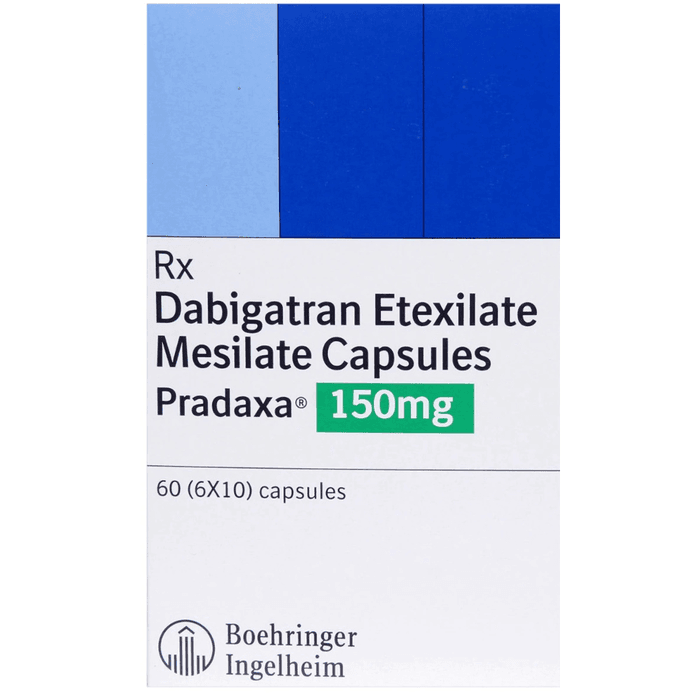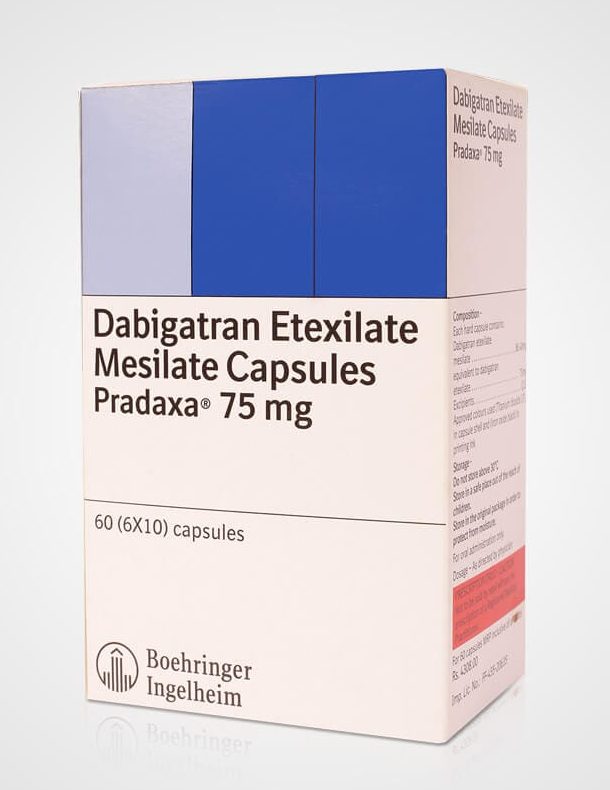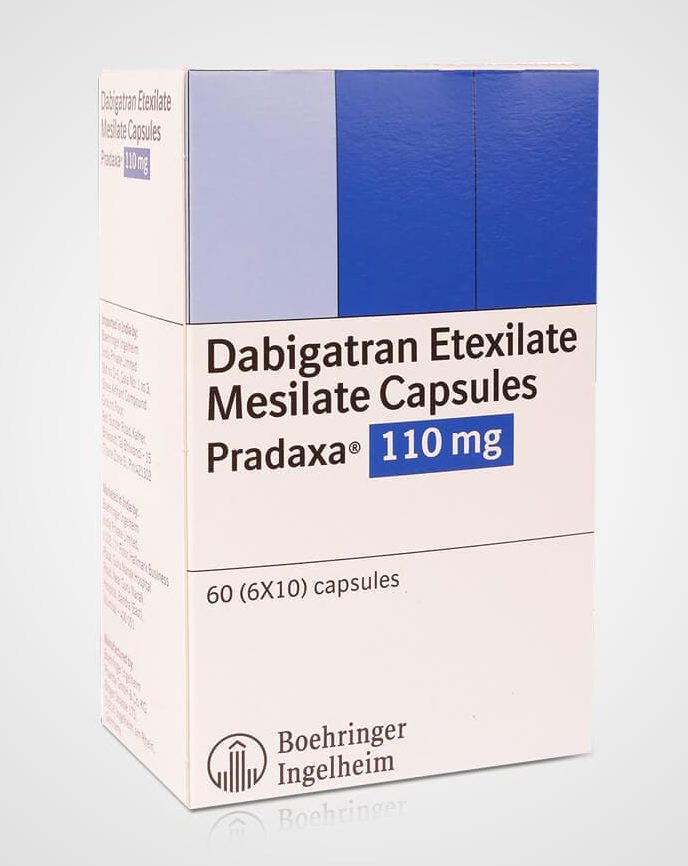Please note: a valid prescription is required for all prescription medication.
Pradaxa® Capsules for Atrial Fibrillation
Sitewide Super Sale - Get 15% off when you buy 3 or more of the same product using the code LESS15 at checkout.
Applies to all products originating from Canada. Maximum quantity limited to a 90-day supply per order.
Price range: $89.99 through $166.30
You save


Pradaxa is a prescription anticoagulant used to help prevent harmful blood clots. It is commonly taken to reduce stroke risk in nonvalvular atrial fibrillation and to treat or prevent deep vein thrombosis and pulmonary embolism. This page explains how the treatment works, who it suits, typical use, safety, and access options.
What Pradaxa Is and How It Works
Pradaxa® contains dabigatran etexilate, a direct thrombin inhibitor that helps stop clots from forming. It blocks thrombin, a central clotting enzyme, which lowers the chance of stroke and systemic embolism in atrial fibrillation and helps treat or prevent DVT and PE. You can order with US shipping from Canada, and pricing information can help you compare options without insurance.
CanadianInsulin.com is a prescription referral platform. We verify prescriptions with your prescriber when required, and licensed Canadian pharmacies dispense your order.
This medicine is taken by mouth as capsules. It works within the body’s clotting pathway and does not require routine INR monitoring. For many adults, it offers a fixed-dose option with fewer dietary restrictions than warfarin. If you want to review costs, you can compare the Pradaxa price alongside alternatives on our site.
Who It’s For
This treatment is used to reduce the risk of stroke and systemic embolism in adults with nonvalvular atrial fibrillation. It is also indicated to treat and help prevent recurrence of deep vein thrombosis and pulmonary embolism after initial therapy with a parenteral anticoagulant. Select patients may receive it to prevent DVT after certain hip replacement surgeries, per label guidance.
It is not recommended for people with mechanical heart valves. Those with severe renal impairment, active pathological bleeding, or a history of hypersensitivity to any component should avoid use unless a prescriber determines benefits outweigh risks. Learn more about the condition it treats in our resources on Atrial Fibrillation and clotting disorders such as Blood Clot DVT PE.
Dosage and Usage
Follow the directions on your prescription label. For nonvalvular atrial fibrillation, the usual adult regimen is taken twice daily. For DVT or PE treatment, a parenteral anticoagulant is typically given first, then this medicine is started and continued twice daily as directed. For prophylaxis after certain orthopedic surgery, the regimen and start timing are based on surgical recovery and hemostasis. Always follow the official label and your prescriber’s instructions.
Swallow capsules whole with water. Do not chew, crush, or open capsules, as this can increase exposure and bleeding risk. Take doses at the same times each day for consistent anticoagulation. If transitioning from or to another anticoagulant, your clinician will advise on timing to avoid gaps or overlap.
If a clinician changes your therapy due to kidney function or interacting drugs, do not adjust on your own. Keep a current medication list and share it at each visit. For broader cardiovascular options, browse our category for Cardiovascular medicines.
Strengths and Forms
Capsules are commonly available in 75 mg, 110 mg, and 150 mg strengths. Color and imprint vary by strength. Packaging may be in moisture-protective bottles or unit-dose blisters. Availability can vary by pharmacy and region.
To compare strength-related costs, review the dabigatran 150 mg price when discussing therapy with your clinician and pharmacy team.
Missed Dose and Timing
If you miss a dose on a twice-daily schedule, take it as soon as you remember on the same day. If the next dose is near, skip the missed dose and resume your regular time. Do not take two doses at once. Adherence is important with anticoagulants because stopping suddenly can raise clot risk.
Set phone reminders or use a daily pill tool that protects capsules from moisture. If hospitalization or procedures are planned, inform your care team well in advance so they can provide instructions based on bleeding and clotting risk.
Storage and Travel Basics
Keep capsules in the original, tightly closed container with desiccant to protect from moisture. Use bottles within the labeled time after opening. If supplied in blisters, only remove a capsule immediately before swallowing. Store out of reach of children and pets.
For travel, carry it in your hand luggage with the prescription label. Keep it dry and away from excess heat or humidity. Bring a current medication list and your prescriber’s contact details. If crossing borders, carry documentation to avoid delays at security or customs.
Benefits
This therapy targets thrombin directly and provides oral dosing without routine INR lab checks. Fixed dosing simplifies daily use for many adults. Compared with older anticoagulants, fewer food interactions may reduce day-to-day restrictions.
Capsule formulation supports consistent dosing. When used as directed, it can help lower the risk of stroke in atrial fibrillation and manage venous thromboembolism under medical supervision.
Side Effects and Safety
- Bleeding, including nosebleeds or bruising
- Gastrointestinal symptoms such as dyspepsia or stomach discomfort
- Indigestion or acid-like symptoms
- Minor gum bleeding
Serious bleeding can occur and may be life-threatening. Seek urgent care for severe, persistent, or unusual bleeding, dark stools, vomiting blood, sudden weakness, severe headache, or confusion. People undergoing spinal or epidural procedures have a risk of spinal or epidural hematoma, which can lead to paralysis. A boxed warning addresses the risk of thrombotic events if the drug is stopped prematurely; consult your clinician before any interruption.
Alcohol, antiplatelets, NSAIDs, and other anticoagulants can raise bleeding risk. For patients on insulin or antidiabetics, hypoglycemia concerns are unrelated to this anticoagulant, but bleeding risk still applies if multiple agents affecting clotting are used.
Drug Interactions and Cautions
Strong P-glycoprotein inhibitors or inducers can alter levels. Examples include ketoconazole, dronedarone, rifampin, and certain antivirals. Renal function changes may require therapy adjustments or alternative strategies. Combining with other blood thinners or antiplatelet drugs increases bleeding risk.
Tell your clinician about all medicines, vitamins, and herbal products, especially St. John’s wort, ginkgo, or high-dose fish oil. If you previously used warfarin, additional reading on alternatives is available in Warfarin for Clot Prevention. Nursing and care considerations for related therapies are covered in Apixaban Nursing.
What to Expect Over Time
Effectiveness depends on taking the medicine consistently and minimizing missed doses. Many people continue long term for atrial fibrillation stroke prevention, while others complete a defined course after DVT or PE. Your prescriber may order periodic labs to assess kidney function and overall safety.
Plan ahead for refills and procedures. Keep open communication about bruising, falls, or new medicines. Most day-to-day activities continue unchanged, but high-impact sports or activities with injury risk may require caution.
Compare With Alternatives
Other direct oral anticoagulants include Eliquis and Xarelto. Choice often depends on clinical factors such as kidney function, dosing frequency, procedural needs, and drug interactions. For background on apixaban, see our overview Apixaban Uses.
Your clinician will help select the right anticoagulant for your condition and risk profile. If a switch is considered, they will provide timing guidance to maintain continuous protection.
Pricing and Access
Canadian pharmacies often list prices that differ from US retail. We display current options so you can assess the pradaxa cost without insurance and compare similar therapies. A neutral guide to savings on related agents is available in Save on Apixaban.
If you are exploring assistance, some patients look for a pradaxa discount card or similar savings programs. For limited-time offers from our store, visit Promotions. Orders ship discreetly and securely, and many items are available with Ships from Canada to US fulfillment for convenience.
Availability and Substitutions
Stock levels can vary by strength and package. If a requested option is not available, your prescriber may recommend a suitable alternative. You can also review the generic molecule on our product page for Dabigatran to understand class-based options before discussing any switch with your clinician.
For transparency on specific capsule presentations, some patients compare the dabigatran etexilate mesylate capsules 150 mg price when discussing long-term therapy planning. Availability by strength may differ between bottle and blister formats.
Patient Suitability and Cost-Saving Tips
People with nonvalvular atrial fibrillation or a history of DVT or PE may be candidates, provided bleeding risk is acceptable. Those with mechanical heart valves, active bleeding, or severe kidney issues may require alternatives. Your prescriber weighs stroke and clot prevention against bleeding risk.
To manage costs, consider multi-month fills if clinically appropriate, which may reduce per-fill fees. Set calendar reminders to request refills early, especially around travel or procedures. For country-based differences, many patients review the pradaxa price in canada when budgeting for ongoing therapy. Our checkout uses encrypted systems for payment security.
Questions to Ask Your Clinician
- My indication and goal: stroke prevention or VTE management?
- How long should I continue therapy for my condition?
- What bleeding signs require urgent evaluation?
- Which drugs or supplements should I avoid?
- How should I handle procedures or dental work?
- What if my kidney function changes over time?
- Are there alternatives if I develop side effects?
Authoritative Sources
- For official US labeling and safety information, see the FDA resource on DailyMed: DailyMed official label database for dabigatran.
- For product details and patient resources from the manufacturer, visit Boehringer Ingelheim: Manufacturer site with prescribing information.
- For Canadian regulatory information, consult Health Canada’s Drug Product Database: Health Canada Drug Product Database.
Order from CanadianInsulin for convenient access with prompt, express, temperature-controlled handling when required.
Medical disclaimer: This content is for informational purposes only and is not a substitute for professional medical advice.
Express Shipping - from $25.00
Shipping with this method takes 3-5 days
Prices:
- Dry-Packed Products $25.00
- Cold-Packed Products $35.00
Standard Shipping - $15.00
Shipping with this method takes 5-10 days
Prices:
- Dry-Packed Products $15.00
- Not available for Cold-Packed products
What is Pradaxa used for?
It is an oral anticoagulant used to reduce stroke risk in nonvalvular atrial fibrillation and to treat or prevent deep vein thrombosis and pulmonary embolism as directed by a prescriber.
How should I take Pradaxa capsules?
Swallow capsules whole with water at the same times each day. Do not chew, crush, or open them. Follow your prescription label and your clinician’s instructions.
Can I stop Pradaxa before surgery or dental work?
Do not stop on your own. Tell your clinician about upcoming procedures. They will provide individualized timing to balance bleeding and clot risk.
What are common side effects?
Common effects include bleeding, bruising, indigestion, and stomach discomfort. Seek urgent care for severe or unusual bleeding, black stools, or symptoms of a serious bleed.
Does Pradaxa interact with other medicines?
Yes. Strong P-gp inhibitors or inducers and other blood thinners can change levels or increase bleeding risk. Share a full medication list with your clinician and pharmacist.
How do I store Pradaxa?
Keep capsules in the original moisture-protective packaging. Use bottles within the labeled time after opening. Store out of reach of children and away from humidity.
What if I miss a dose?
If you miss a dose on a twice-daily schedule, take it when remembered the same day. Skip it if the next dose is near. Do not take two doses together.
Rewards Program
Earn points on birthdays, product orders, reviews, friend referrals, and more! Enjoy your medication at unparalleled discounts while reaping rewards for every step you take with us.
You can read more about rewards here.
POINT VALUE
How to earn points
- 1Create an account and start earning.
- 2Earn points every time you shop or perform certain actions.
- 3Redeem points for exclusive discounts.
You Might Also Like
Related Articles
Low Income Medication Help: Steps To Reduce Prescription Costs
Key TakeawaysIf low income medication costs are forcing tough choices, focus on the “next refill” problem first.Start with your exact drug name and strengthCompare cash, insurance, and assistance pathwaysAsk about…
Zepbound storage: Keep It Safe With Clear Temperature Rules
This guide explains Zepbound storage so your medication stays effective. You will learn temperature limits, how long doses can stay unrefrigerated, travel practices, and what to do if a pen…
Zepbound and Fatigue: Practical Tips to Ease Tiredness Safely
Feeling drained after starting tirzepatide can be unsettling. Many users describe a mix of low energy, mild aches, and disrupted sleep early on. If you are navigating Zepbound and fatigue,…
Mounjaro Heart Benefits Beyond Weight Loss: What Matters
Key Takeaways Beyond weight: Heart-related effects may involve blood sugar, blood pressure, and inflammation. Evidence is evolving: Large outcome trials help clarify real-world heart risk. Heart rate can rise: Small…



